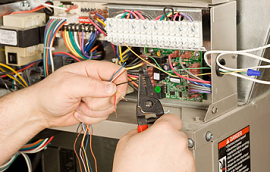Back in the old days, it wouldn’t be uncommon to install a gravity furnace that only had a handful of parts, no fan to circulate air and a cast iron heat exchanger. These older furnace models had no electronic systems in place, and they would last a long time. These days, a furnace is a more complicated piece of equipment with improved efficiency and performance. This comes at the price of reduced durability and a shorter useful lifespan. Let’s examine how furnaces have changed over the years and how long a modern furnace should last.
The Quest for Higher Furnace Efficiency
There are older designs of gravity furnaces still operating all over America today. Many of these furnaces were converted from coal to run on either oil or natural gas, and some are over five decades old. Even the staunchest supporters of these older rugged gravity furnaces would still have to concede that they are not the most efficient furnaces available. A typical gravity furnace would waste 40-50% of whatever type of fuel that was used in it and for this reason a change was desperately needed.
In the early 1970s, new government regulations combined with increasing market demand for more efficient furnaces forced manufacturers to improve energy efficiency. The first two innovations implemented were a fan to push the treated air through the home and thinner heat exchanger walls. These two improvements alone pushed the energy efficiency figures to over 70% on average. Then, electronic ignition systems, exhaust control fans, and a second heat exchanger, were also added to boost energy efficiency numbers to 90%. Later still, computers were added to control and regulate these technologies, and this managed to push efficiency up to 98%.
The Durability Tradeoff
The gains in efficiency over the years have benefitted many furnace users with lower energy bills and improved performance. This has come at a cost in terms of durability and longevity. A thinner heat exchanger wall is more prone to cracking and causing leaks. Electronic ignition systems need to be cleaned regularly and need periodic replacement. The added fan motors on a modern furnace will wear over time and eventually need to be replaced entirely. For these reasons a modern furnace will be far more energy efficient, but will not last anywhere near as long as an old gravity furnace.
The Modern Furnace Lifespan
A modern gas furnace lifespan is likely to last 15-20 years dependant upon a number of factors. First, the air filter will need to be changed regularly; this will ensure that the airflow is maximized and reduces system strain. The entire system needs to be serviced and cleaned twice each year by a certified HVAC professional. The furnace must be correctly sized to fit the home to ensure that it isn’t overworked or inefficient in operation. If these tasks are consistently carried out a modern furnace could have a useful lifespan closer to the 20 year mark before it needs to be replaced.
